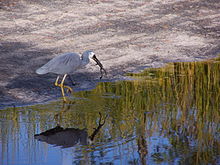Egretta
| Egretta Temporal range: Late Miocene to present | |
|---|---|

| |
| White-faced heron, Egretta novaehollandiae | |
| Scientific classification | |
| Domain: | Eukaryota |
| Kingdom: | Animalia |
| Phylum: | Chordata |
| Class: | Aves |
| Order: | Pelecaniformes |
| Family: | Ardeidae |
| Subfamily: | Ardeinae |
| Genus: | Egretta T. Forster, 1817 |
| Type species | |
| Ardea garzetta[1] Linnaeus, 1766 | |
| Species | |
|
See text. | |
Egretta is a genus of medium-sized herons, mostly breeding in warmer climates.
Representatives of this genus are found in most of the world, and the little egret, as well as being widespread throughout much of the Old World, has now started to colonise the Americas.
These are typical egrets in shape, long-necked and long-legged. A few plumage features are shared, although several have plumes in breeding plumage; a number of species are either white in all plumages, have a white morph (e.g. reddish egret), or have a white juvenile plumage (little blue heron).
The breeding habitat of Egretta herons is marshy wetlands in warm regions. They nest in colonies, often with other wading birds, usually on platforms of sticks in trees or shrubs.
These herons feed on insects, fish, and amphibians, caught normally by cautious stalking.
Taxonomy


The genus Egretta was introduced in 1817 by the German naturalist Johann Reinhold Forster with the little egret as the type species.[2][3] The genus name comes from the Provençal French for the little egret, aigrette, a diminutive of aigron, "heron".[4]
As with other heron groupings, the taxonomy of these birds has been a source of dispute. Some of these species have been placed with the great herons in Ardea, and conversely, the large white species such as the great egret are occasionally allocated to Egretta. The fact that some members of the genus have common names of "heron" and some of "egret" , causes further confusion in differentiating between this genus and Ardea.
Species
The genus contains 13 species:[5]
| Image | Scientific name | Common Name | Distribution |
|---|---|---|---|
 |
Egretta picata | Pied heron | Australia, Wallacea and New Guinea. |
 |
Egretta novaehollandiae | White-faced heron | of Australasia, New Guinea, the islands of Torres Strait, Indonesia, New Zealand |
 |
Egretta rufescens | Reddish egret | Central America, The Bahamas, the Caribbean, the Gulf Coast of the United States, and Mexico. |
 |
Egretta ardesiaca | Black heron | Sub-Saharan Africa, from Senegal and Sudan to South Africa, Madagascar |
 |
Egretta vinaceigula | Slaty egret | south-central Africa. |
 |
Egretta tricolor | Tricolored heron, Louisiana heron | Gulf of Mexico and the Caribbean, to northern South America as far south as Brazil. |
 |
Egretta caerulea | Little blue heron | United States, through Central America and the Caribbean south to Peru and Uruguay |
 |
Egretta thula | Snowy egret | North, Central and South America. |
 |
Egretta garzetta | Little egret | Europe, Africa, Asia, and Australia. |
 |
Egretta gularis | Western reef heron | southern Europe, Africa and parts of Asia |
 |
Egretta dimorpha | Dimorphic egret | Comoros, Kenya, Madagascar, Mayotte, Seychelles, and Tanzania. |
 |
Egretta sacra | Pacific reef heron, Pacific reef egret, or eastern reef heron | southern Asia and Oceania. |
 |
Egretta eulophotes | Chinese egret | east Asia. |
A fossil species, Egretta subfluvia, is known from the Late Miocene or Early Pliocene of Florida.
References
- ^ "Ardeidae". aviansystematics.org. The Trust for Avian Systematics. Retrieved 2023-07-27.
- ^ Forster, T. (1817). A Synoptical Catalogue of British Birds; intended to identify the species mentioned by different names in several catalogues already extant. Forming a book of reference to Observations on British ornithology. London: Nichols, son, and Bentley. p. 59.
- ^ Mayr, Ernst; Cottrell, G. William, eds. (1979). Check-List of Birds of the World. Vol. 1 (2nd ed.). Cambridge, Massachusetts: Museum of Comparative Zoology. p. 204.
- ^ Jobling, James A (2010). The Helm Dictionary of Scientific Bird Names. London: Christopher Helm. p. 143. ISBN 978-1-4081-2501-4.
- ^ Gill, Frank; Donsker, David; Rasmussen, Pamela, eds. (July 2021). "Ibis, spoonbills, herons, Hamerkop, Shoebill, pelicans". IOC World Bird List Version 11.2. International Ornithologists' Union. Retrieved 21 November 2021.


